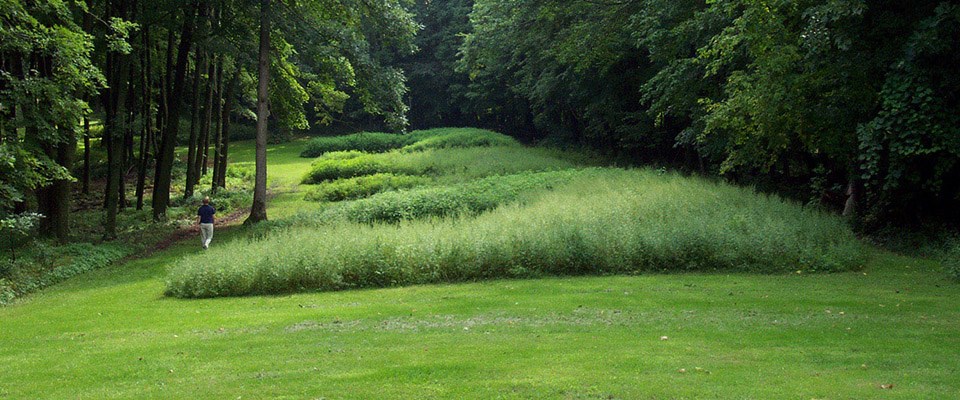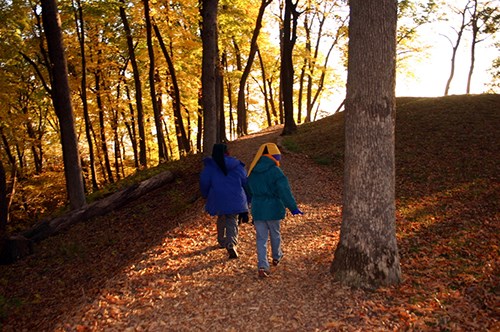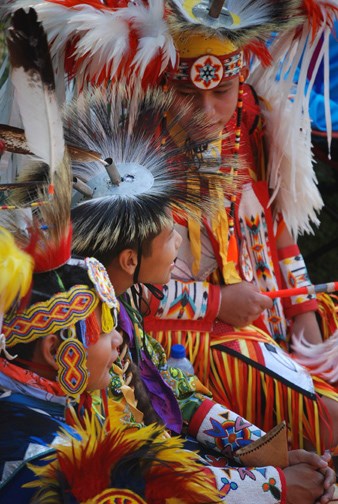"Finding ways to involve tribes directly in the management of the landscape is an important goal."
Article
Effigy Mounds National Monument: Tribal Collaboration for Landscape Management
Over twenty years have passed since the National Park Service started developing and consistently improving an evolving strategy for documenting and caring for cultural landscapes. Native Americans, however, have been managing landscapes for generations.
At the conference A Century of Design in the Parks: Preserving the Built Environment in National and State Parks, June 21-23, 2016, Brenda Williams of Quinn Evans Architects reminded participants that:
For thousands of years, the North American landscape was populated by a diversity of cultures whose life ways and traditions resulted in a wide range of relationships between people and the land. Over time, their activities left impressions on the landscape, many of which are recognizable today. The members of today’s tribal nations are the descendants of the earliest inhabitants of this continent. Their knowledge and traditions can provide guidance for protecting and understanding landscapes associated with their ancestors. Integration of current American Indians into planning and management for cultural landscapes can improve the sustainability, authenticity, and meaningfulness of these significant places.
As planners and designers, we work to protect significant places while creating inspiring experiences for those who visit. In the case of places that are culturally significant, their full and true value is best understood from the perspectives of the people who are culturally associated with the place. It follows that, to truly conserve Indigenous cultural landscapes, associated peoples must be included in the planning and design process.

NPS Photo
Effigy Mounds National Monument
Effigy Mounds National Monument located in Northeastern Iowa was established to protect prehistoric earthworks – namely “effigy” mounds in 1949. As part of the Mission 66 Program, the park was developed to include “trails, buildings, overlooks, and interpretive materials to explain our (Euro-American) ideas of the extinct culture.” The layout of the park was based on the archeological record available at the time and had a goal of immersing visitors into a resource estimated to have been constructed between 500 B.C. and 1300 A.D. Assumptions were made at that time “that the mound builders were a lost culture with no connections to current Indigenous American groups.”

NPS Photo
In 2013, funding was secured to create a Cultural Landscape Report (CLR). The process for creating this document recognized the on-going significance of the landscape to existing Native American Tribes and involved active consultation in determining the best management practice to achieve a desired condition for the mounds.
This effort not only opened up a new chapter in planning for the park, but it has also shaped an understanding of cultural association. Superintendent James Nepstad indicated that the CLR effort at Effigy Mounds, “…was an excellent example of tribal collaboration on a critically-important project.”
The CLR, completed in 2016, is now ready to be implemented. In direct contrast to the Mission 66 effort that shaped the park, future changes to the Effigy Mounds Cultural Landscape will be sensitive to ethnographic associations and values and will not be made in haste. The goals of the CLR will involve active consultation that brings the culture that shaped the landscape back to it in tangible ways.
Superintendent Nepstad indicated that:
The hands-on work has yet to begin, but we will be discussing clearing expansion at our next consultation. The CLR envisions significant expansion of the clearings around the mounds - slow and gradual expansion, taking advantage of natural die-offs and blow-downs.
The park experienced a significant wind event this summer (2017). This presents an opportunity to start pushing the forest back in the areas affected. The process is expected to be slow, “but it is important to start, and to start well.” The park would like active involvement from the associated tribes not in just the planning, but hands on as well.

NPS Photo
The involvement of tribal partners in the planning and management of the landscape is an opportunity to educate and involve the next generation of tribal leaders in a tangible way. According to the Superintendent,
There has been talk of involving Ho-Chunk youth in the management of marker trees in the park - maybe even in replacing one that recently died. Finding ways to involve tribes directly in the management of the landscape is an important goal.
The Park Cultural Landscape Program supports the staff and tribes dedicated to the management of Effigy Mounds National Monument and commends them for not only taking the first step, but contributing to the program’s methodology. This recognition of and commitment to an on-going dialogue and implementation of the CLR serves as an example for all landscape managers tasked with preserving places and the culture.
Last updated: May 17, 2019

